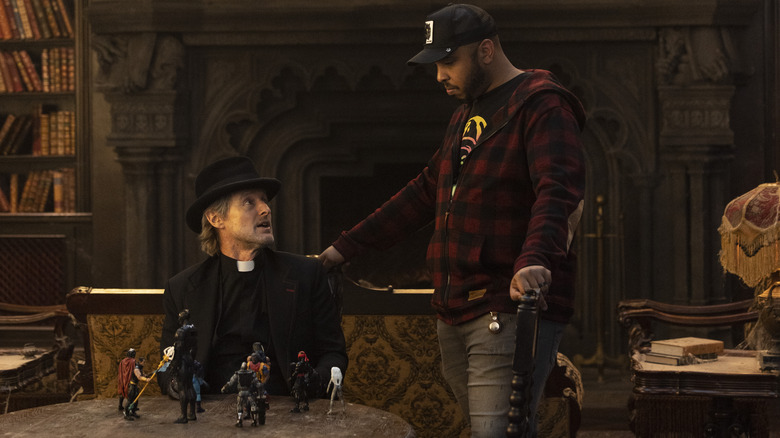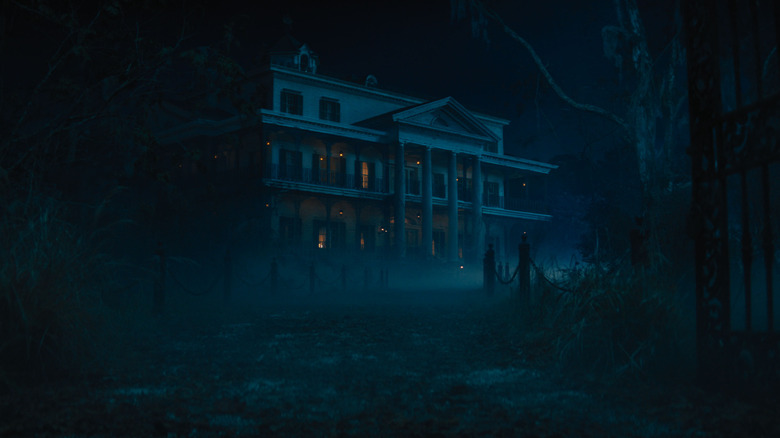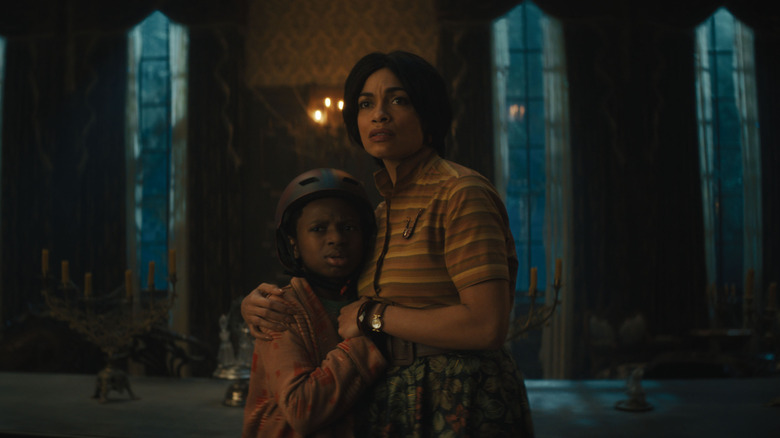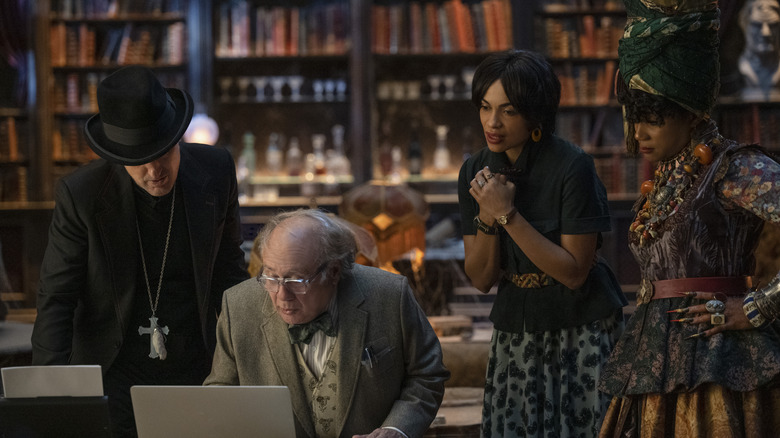Haunted Mansion Director Justin Simien On His New Orleans Roots & Cinematic Influences [Exclusive Interview]
If you thought making a superhero movie or a "Star War" as your first major blockbuster came fraught with the most pressure of any IP, well, may I kindly direct you to the theme park aficionados out there. Filmmaker Justin Simien would know. He's one of them.
The "Haunted Mansion" director has never quite tackled a production as large and with as many eyeballs on it as this one, but you wouldn't assume it from talking to him. He's all too eager to deftly spread the praise around like a seasoned pro, particularly to his creative team that helped him shape a movie that has remained in the thick of development hell for years. (At one point, none other than horror maestro Guillermo del Toro was attached to write and direct.) And yes, with the WGA and SAG-AFTRA strikes currently ongoing, it's been left to the directors to take on the bulk of promotion for their respective projects ... but that doesn't mean Simien shies away from heaping all due praise on writer Katie Dippold. Just the opposite, in fact.
When I conducted this interview with the director over Zoom, we covered a lot of ground about how "Haunted Mansion" came to the big screen in its current form. Simien didn't hesitate to passionately talk my ear off about Dippold's invaluable contributions to the film with her screenplay, Simien's New Orleans upbringing and how that informed his big pitch to Disney, his status as a self-professed "Disney adult" and his familiarity with the Haunted Mansion ride from his days of working at Disneyland, and a host of cinematic inspirations that range from the obvious to the surprising.
Note: This interview has been lightly edited for clarity and brevity.
'Wouldn't it be cool if we could really root the Haunted Mansion in real New Orleans?'
Disney has had all these various attempts to get the movie made over the years. What do you feel like you finally brought to the table that nobody else did and what was your pitch to the studio when you first joined?
Oh wow. Well, I don't know if I can say what nobody else did. I'm dying to see Guillermo del Toro's version of this movie, too. That was all before my time, but when I read the script by Katie Dippold — and part of why I'm doing press today is to talk about her, she's a brilliant female writer who can't speak for her work [due to the ongoing WGA strike] — that's what made me say yes, and it did so many things right that I thought were important for me to try and protect as a director. Things that I knew could maybe get scrubbed away if it was someone else doing it. She really goes there in terms of grief and fear and also doesn't pull any punches in terms of laughs, either.
I felt really protective of those elements and I was really turned on by it because, one, it's an ensemble comedy that's kind of shady and sarcastic and it Trojan Horses this whole other story about grief and loss, and that's my bag. If you look at "Dear White People," that's what that is. It's an ensemble comedy that Trojan Horses a lot of topics that, if it wasn't a comedy, nobody would let us really talk about [laughs]. And then the other side of it is that, I'm kind of a Disney adult. I rode [Haunted Mansion] when I was a kid. I rode it over and over again as an adult. I worked at Disneyland. I was obsessed, from my filmmaker brain, obsessed with the Haunted Mansion because it's production design, it's movie, it's cinema. Your eyes are being guided, it's literal smoke and mirrors, it's Pepper's ghost effects, it's the stuff of making a movie.
My last film, "Bad Hair," is a horror movie. We shot it on Super 16, had all these practical effects that, oh, that's the best [laughs], that is the best feeling. And so I wanted to take that love of practical effects, that love of how the ride was built, keep this thing from being CGI soup and demand certain things. Like, we have to incorporate Hatbox Ghost and we have to build these sets and no matter what happens, if it's a ghost or if something's flying through a wall, build the wall, put the ghost on that set! Let's have physical things in-camera. That was super important to me.
And I'd say the other category was, I love Haunted Mansion, but the version of New Orleans that the ride is set in doesn't look like the New Orleans that I know. My family is from Louisiana, I'm very familiar with New Orleans. It's a very Black city and it's a really important city, because it's where jazz comes from and it's where gumbo comes from. It's where the best food in the country comes from. And the reason why is because you had Black people, the Spanish people, Native Americans, all of these people mixing and mingling and becoming rich and forming an aristocracy. And all these things happened in this part of the world before they went away for a bit.
And I thought, "Wouldn't it be cool if we could really root the Haunted Mansion in real New Orleans?" If you do that, you really set up a movie where people can accept things like laughter and tears and all that stuff to live in the same place because that's New Orleans, baby. People trying to survive and make life beautiful in a hot swamp [laughs] for a limited piece of time in history. I was really passionate about those three things and that seemed to be exciting to the gatekeepers that kept saying yes to me.
'Blends of horror and comedy and sweetness and dark and light'
I'm glad you mentioned that balance between comedy and tears, but there's also the horror. That's something that's beloved in the original ride, too.
Yeah.
When you're making this movie, how did you combine those without one overwhelming the other?
I mean, I grew up on that stuff. The first horror movie I saw was "Nightmare on Elm Street." I was five years old and I didn't — well, maybe I did turn out kind of weird, but it worked in my favor [laughs]. I think, again, I watched these movies growing up. I watched "Snow White" and "Pinocchio," these movies are terrifying [laughs]. Okay, they are blends of horror and comedy and sweetness and dark and light. As a kid, they make you feel like you can face the darkness of the world. And as a Black gay kid whose dad died, my world growing up was kind of scary. And these movies made me feel like I could get through it.
So a lot of it was me just really leaning on my instinct. I don't know how to write drama without being funny and I don't know how to write comedy without being serious. I don't know how to do it. They just live side by side in my brain. So I leaned into those instincts and the rest was the usual conversations between the studio. There's testing, there's all that kind of stuff, but a lot of it was like me making the movie I wanted to see [laughs].
There's so much mythology and lore that goes into this property. How do you figure out that balance of including those references and those Easter eggs for the diehard fans out there, but also making it accessible to the people whose first introduction to Haunted Mansion might be this movie?
Well, again, it starts on the page. Katie wrote a script that did exactly that. She finds a way to focus on characters who, like us, are entering the Mansion for the first time. They're experiencing the Mansion you do the same way you would if you were on the ride, and at the same time, make it essential that they figure out these various mysteries that go on. I thought that was a really brilliant way in, because it makes a movie version that actually takes you on the same emotional journey as the ride itself does. So some of that was done just by the script.
'Literally everything that moves in this movie is based upon some deep-cut knowledge and research'
Do you have a favorite deep-cut reference that you snuck into the movie and you're hoping that viewers will pick up on when they see it?
Oh man, I would say, look at the paintings. Because some of them, we pull your eyes to the paintings that change and sometimes we don't pull your eyes to the paintings that change. And literally everything that moves in this movie is based upon some deep-cut knowledge and research [laughs]. Part of it was, I'm a research head. My production designer was a big research head. I brought in my cousin Jeremy Simien, who is an art historian in New Orleans, and we just pulled up all of this research. Jeffrey Kurland, who did the costumes.
There was just all of this research and we really tried to figure out, how did the Imagineers arrive at some of these choices? What research were they looking at? And then, how do we fill in the gaps that are left? And what stayed is the stuff that told the story we were telling. What had to maybe hit the cutting room floor or be part of bonus content or maybe wait till next time, is the stuff that was really cool but didn't tell the story in an immediate way that would matter to the audience. And there's a lot of darlings we had to kill to do that work, man, but that was part of the job.
Obviously the ride itself was probably the biggest touchstone for you in terms of influences and inspirations. Did you look to other movies, like how "Pirates of the Caribbean" was based on a theme park ride and then turned into a movie, or the original Eddie Murphy "Haunted Mansion," maybe even "Ghostbusters" or anything like that?
Oh my God, that's my favorite part, is building the movie playlist before I make the movie. That's my favorite part! I'll say "The Haunting," the Robert Weiss movie from 1963, was a huge touchstone. Because when I finally got into the research about the ride, I realized so much of what the Imagineers are channeling are the vibes of that movie, which came just a few years before. Things that you don't even think about, but the way the mirrors sort of hang from the ceilings, the way hallways are visible across from other hallways, but they're just off-angle so the house feels like something's not quite right. Hiding little faces. So much of that stuff is happening in "The Haunting," so that's a movie I've watched a lot and had folks watch a lot.
But then it's the fantasy comedies, particularly the ones that have fanciful production design and practical effects. "Little Shop of Horrors" was a big one. "Ghostbusters," absolutely. But definitely "Beetlejuice," too. Also, even "Pee-wee's Big Adventure." These movies that are ostensibly made for kids, but are absolutely subversive and become different movies as you watch them over time growing up. That was the sweet spot for me. So it's kind of between 1963 and 1993, there was a lot of movies in that area that we watched over and over again. "The NeverEnding Story" is another one, "Return to Oz" is another one. Lots of movies that do the same balance between horror/comedy/families.
"Haunted Mansion" hits theaters on July 28, 2023.



